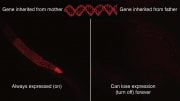
A team of KAUST researchers used nematode worms to explore how short-term genetic memories can be inherited across generations. Credit: © 2022 KAUST; Veronica Moraru
A gene-silencing tool could enable new opportunities for advancing basic biomedical research and drug development.
The technique draws on the power of small noncoding RNA molecules that normally suppress gene activity. Known as Piwi-interacting RNAs, or piRNAs, these regulatory molecules normally play a critical role in bringing genomic parasites to heel.
But geneticist Christian Frøkjær-Jensen and his colleagues at KAUST co-opted this piRNA pathway to deliberately quell the activity of target genes of interest.
Working in nematode worms — a common laboratory model for genetics research — Frøkjær-Jensen’s team created synthetic 21-letter RNA sequences that interacted with the natural piRNA machinery to silence intended genes.
As a proof of principle, the researchers designed such “guide piRNAs” directed against two genes involved in determining worm sex, thereby skewing the ratio of male-to-female offspring. Using this piRNA-mediated interference mechanism —piRNAi for short — they also silenced many other genes, either alone or in a multiplexed manner.
“We have reprogrammed a pathway that normally guards the organism’s genome,” Frøkjær-Jensen says. “Our technique is an important step in enabling precise and scalable biological engineering of a very simple living organism.”
What’s more, since the same gene-silencing pathway is found in humans, Frøkjær-Jensen notes, “it is interesting to consider whether piRNAi could be used as a potential therapeutic in people.”
Already, other gene-specific silencing tools, including conventional RNA interference and CRISPR-based gene editing, are being used in patients to fix genetic diseases. But these methods do not always work well for all gene targets in worms.
The new approach from Frøkjær-Jensen’s team expands the molecular toolkit for gene manipulations and allows for more detailed investigations in the model laboratory species.
The researchers have developed a web portal for scientists anywhere to generate their own piRNAi designs.
Frøkjær-Jensen’s own research focuses on understanding how short-term genetic memories can be inherited across generations. So, his group examined how long piRNAi-mediated gene silencing might last, from parent to offspring and beyond.
As it turned out, different genes could be turned off for different lengths of time, ranging from one to six generations. However, the researchers could also make the gene silencing permanent by depleting the entire piRNA pathway, showing how the same mechanism is needed first to initiate but then also to limit the inherited epigenetic state.
“We find these short-term memory systems fascinating,” says Monika Priyadarshini, who developed piRNAi as a graduate student in Frøkjær-Jensen’s lab. “Our tool will help us and others understand how epigenetic memories are passed on, and whether higher organisms such as humans have similar systems.”
Reference: “Reprogramming the piRNA pathway for multiplexed and transgenerational gene silencing in C. elegans” by Monika Priyadarshini, Julie Zhouli Ni, Amhed M. Vargas-Velazquez, Sam Guoping Gu and Christian Frøkjær-Jensen, 3 February 2022, Nature Methods.
DOI: 10.1038/s41592-021-01369-z









Be the first to comment on "Silencing Tool Suppresses Gene Activity Across Generations"